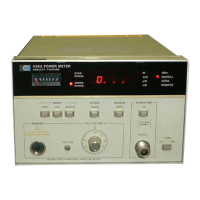•
•
Model 436A
DESCRIPTION
(cont'd)
overrange indicators. There
is
a
20
percent
overrange capability in all ranges. Large
10
mm (0.375
inch) digits are easy
to
see even
in a high glare environment.
•
Auxiliary Meter: Complements the digital
display
by
showing fast changes in power level.
Ideal for
"peaking"
transmitter
output
or
other variable power devices.
•Choice
of
Display
in
Watts, dBm
or
dB:
Absolute power can be read
out
in watts or
dBm. Relative power measurements are made
possibile with
the
dB [REF] switch. Pressing
this switch zeros
the
display for any applied
input
power and any deviation from this
reference is shown in dB with a resolution
of
±0.01
dB. This capability is particularly useful
in frequency response testing.
• Power
Units
and Mode Annunciator: The units
annunciator provides error-free display
interpretation by indicating appropriate power
units in
the
watt
mode. The mode annunciator
indicates the
mode
of
operation: dBm, dB
(REL),
ZERO
or
REMOTE.
•
Completely Autoranging: The
Power
Meter
automatically switches through its 5 ranges
to
provide completely
"hands
off"
operation.
The RANGE
HOLD switch locks
the
Power
Meter in one
of
its ranges when autoranging
is
not
desired.
•Automatic
Sensor Recognition: The
Power
Meter continually decodes the sensitivity
of
the Power
Sensor
to
which
it
is
connected.
This information is
then
used
to
automatically
control
the
digital display decimal
point
location and, when
WA
TT
MODE
operation
is
selected,
to
light
the
appropriate power units
annunciator.
•Auto
Zero:
Zeroing
the meter
is
accomplished
by merely depressing
the
SENSOR ZERO
switch and waiting until the display shows all
zeros before releasing it. The meter
is
ready
to
make measurements
as
soon as
the
zero light
in the mode annunciator
goes
off.
•
RF
Blanking
Output:
Open
collector TTL; low
corresponds
to
blanking when the sensor zero
is
engaged,
May be used to remove the
RF
input signal connected
to
the power sensor.
•Calibration
Accuracy: A 1.00
mW,
50
MHz
reference
output
is
available
at
the
front
panel
General Information
for calibrating the
Power
Meter and the
Power
Sensor as a system. Calibration
is
accomp-
lished using
the
CAL ADJ and CAL FACTOR
% controls. The CAL ADJ control compen-
sates for slight differences in sensitivity
associated with a particular
type
of
Power
Sensor and the CAL
FACTOR
% control
compensates for mismatch losses and effective
efficiency over
the
frequency range
of
the
Power
Sensor.
• Recorder
Output:
Provides
a linear
output
with respect
to
the
input
power level.
For
each range, a
+l.00
Vdc
output
c;orresponds
to
a full scale
input
power level. Refer
to
Table 1-1, Specifications,
for
the
full-scale
range values associated with the various types
of
Power
Sensors available.
1-17. The Hewlett-Packard
Interface Bus
(HP-IB)
Option 022
allows full remote control operation
of
all
the
power meter functions (CAL
FACTOR
can be programmed
to
either
100%
or
the CAL
FACTOR
which has been manually set on
the
front
panel). This option may be added
by
the
user
at
a later time as his requirements grow.
1-18.
OPTIONS
1-19.
Input-Output Options
1-20. Option 003.
A rear panel
POWER
REF
OUTPUT connector replaces
the
standard front
panel connector.
1-21.
Option 004.
The 1.5 metre (5 ft.) power
sen-
sor cable
is
not
shipped with
the
power meter.
1-22. Remote Control
Options
1-23.
Option
022
adds remote interface capability
to
the
Power
Meter.
Option 022
is compatible with
the
Hewlett-Packard
Interface Bus
(AHl,
CO,
DC2,
DTl,
L2,
LEO,
PPO,
RL2,
SHl,
SRO,
T3,
TEO).
1-24.
Option 022
may be ordered in kit
form
under
HP
part
number
00436-60035.
The kit
contains a control assembly printed-circuit board,
an
input/output
assembly printed circuit board,
and a
data
cable for interconnection.
1-3

